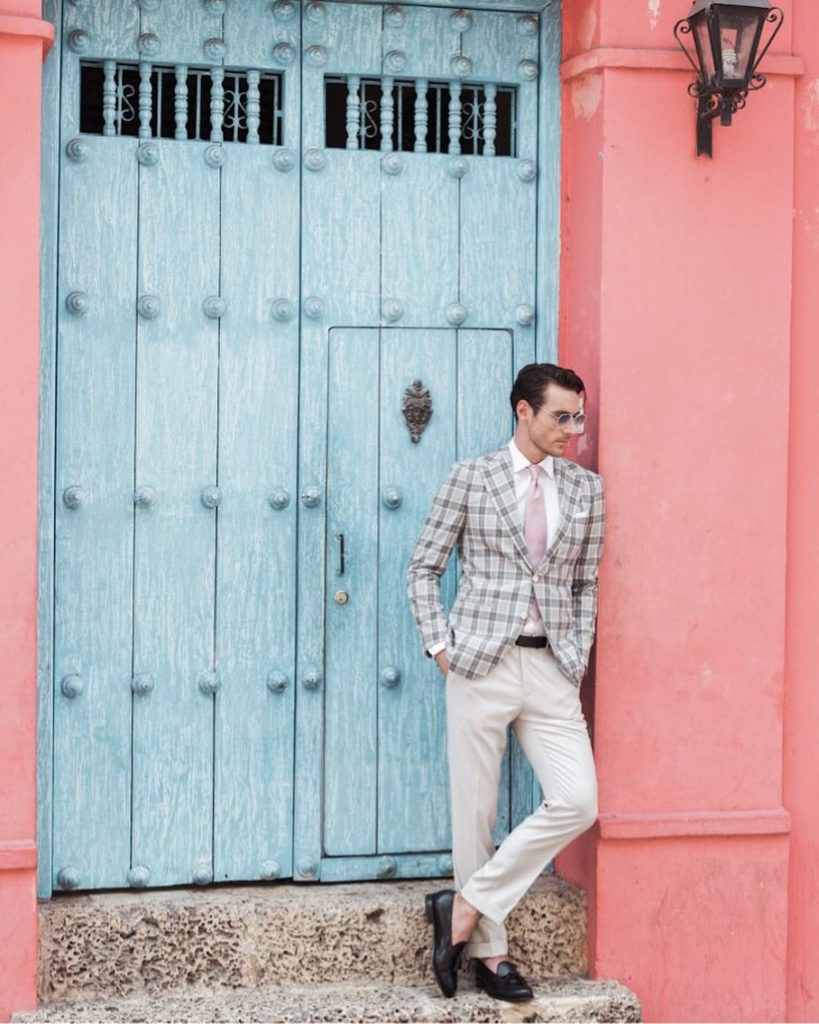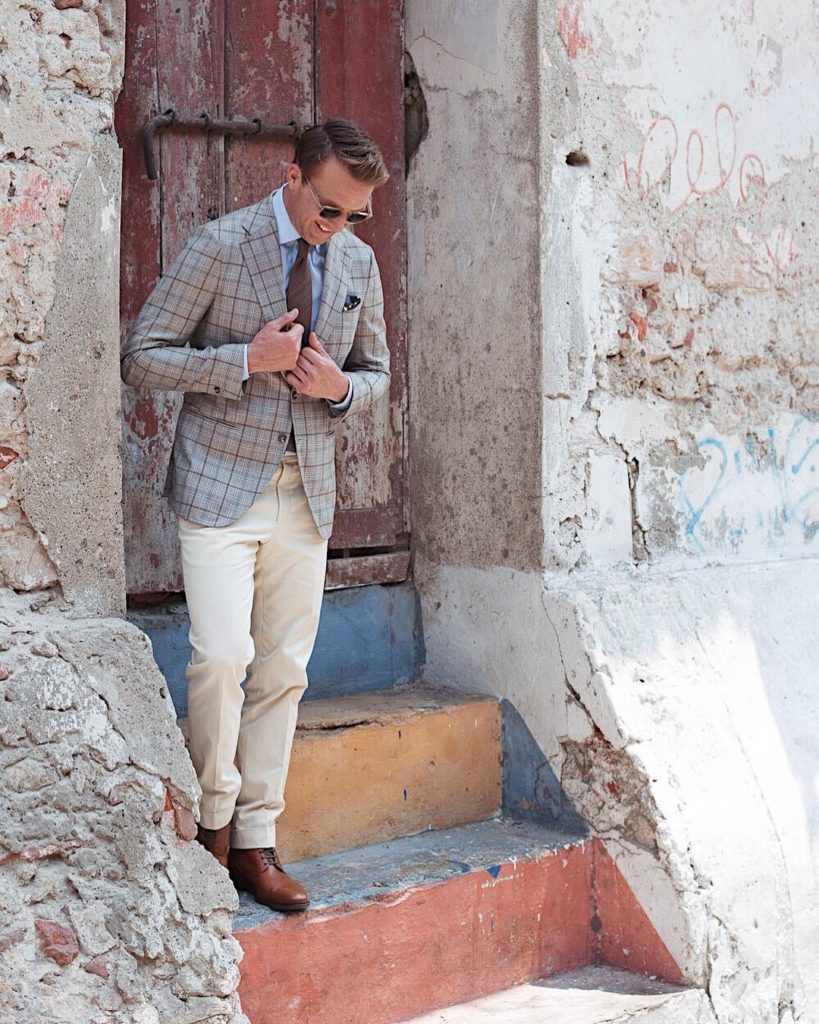At first glance, chinos and khakis are, like Henry Cavill and Matt Bomer, difficult to tell apart. Many people use the terms interchangeably to describe any kind of casual pants, thus muddling any real understanding of the differences between the two. Stay on the informed side of the style spectrum by exploring the origins of and distinctions between chinos and khakis, then learn how to consider color, seasonality, and occasion when selecting the pants that would work best for you.
Chinos vs Khakis: The Differences at a Glance
A step up in dressiness from jeans and a step down from suit trousers, chinos and khakis are both appropriate choices for any casual setting where you want to look pulled together yet unfussy. More alike than different, chinos and khakis nonetheless have a few differences:
- Khakis are the heavier of the two styles. They’re made from thick cotton twill and are typically cut with a wide, straight leg. Many khakis feature pleated fronts, though pleating isn’t a requirement; khakis also usually—though not inevitably—feature visible stitching and pronounced cuffs. Khakis are durable and warm, which makes them well suited for wearing outdoors.
- Chinos, meanwhile, are cut from lightweight cotton twill and are often worn in warm climates and summer months. Chinos have no pleats and are more likely to be hemmed than cuffed; they’re usually slim cut, with a slight taper from the knee to the ankle. Due to the tapered finish and clean, flat front, chinos are considered the dressier option of the two.
Note, however, all the equivocation in the preceding definitions. The boundary between chinos and khakis is fluid: Cotton twill trousers without pleats or cuffs are not automatically considered chinos any more than straight-legged cuffed trousers are automatically considered khakis. If you refer to your chinos as khakis or to your khakis as chinos, you are unlikely to be corrected by any but the most fastidious fashionista.
But Where Do They Come From?
Khakis and chinos both have very specific military-based origins. Named for either a Hindi or Urdu word—accounts vary—for soil-colored, khakis originated in India under British Colonial rule in the 1840s, when soldiers in the British Indian Army dyed their white uniforms with dust, tea, or curry to blend in with their surroundings.
Chino cloth, on the other hand, originated in China as a cheap and durable fabric for peasant workers. The name comes from the Spanish term for “Chinese Pants”: pantalones chinos. Used as part of the US Army uniform in World War II, chinos experienced a postwar boom in popularity throughout the Western fashion world when they flooded into military surplus stores and secondhand shops, eventually becoming a common sight in the American workplace.
Khakis Aren’t Always Khaki
The word khaki is a metonymy, used to describe both the specific sage-buff color of the original fabric and the range of casual trousers associated with that color. While terms khakis and chinos both evoke images of pants in shades of sand, beige, and sage, khakis and chinos can come in any color. You can easily find khakis in a range of rich earth tones, such as browns, greens, beiges, and maroons, while it’s not uncommon to see chinos in more striking hues, such as reds, blues, whites, and pastels.
How—and When—to Wear Each
Since khakis are heavier and more durable than chinos, their versatility stretches to outdoor activities and most informal events. Khakis work best with casual tops such as polos, fitted t-shirts, and sweaters suited for outdoor use. As they tend to come in earthy tones, khakis pair especially well with rich, saturated tones: deep reds, blues, and dark greens. Plaid, too, tends to be a good match for khakis.
Steve McQueen and Paul Newman were style icons who popularized khakis by lending a certain unruffled glamour to this workmanlike garment. The scenarios in which they were seen wearing their khakis—piloting boats, riding motorcycles, strolling on beaches—speak to the rugged aesthetic best suited to these trousers. Wear your khakis for casual occasions, such as the following:
- BBQs, backyard parties, and other outdoor gatherings
- Business travel
- Informal office-related events, such as company picnics
- Casual Fridays at work
- Weekend brunch
- Holidays and family parties
Chinos can be your go-to trousers for events and situations that call for a polished look, but where a suit would be overkill. In general, chinos look more appropriate than khakis at the office. The flat front and tapered leg mean they pair especially well with button-ups and dress sweaters; you can dress them up still further by adding a tie and finishing the outfit with a blazer and Oxfords or loafers. Reach for your chinos when getting ready for:
- Business casual workplaces
- Dinner parties
- Evenings out with friends
- Dates
- Outdoor weddings, or weddings where the invitation stresses casual dress.
The Fit Always Matters
Khakis and chinos are versatile trousers that each work best in different situations. Whether you’re dressing up your chinos for a wedding or taking your khakis for a leisurely beach stroll, the key to looking sharp in any environment is the fit. Tapered or straight, pleated or flat, beige or magenta, khakis and chinos only hit their mark when they fit the man who wears them. A pair of custom-made trousers from Knot Standard, sewn together from a pattern created exclusively for you from your exact measurements, will suit you much better than any off-the-rack option. Custom menswear also gives you nearly unlimited options in terms of fabric, cut, and personalized details. To explore the Knot Standard difference for yourself, schedule an appointment with a stylist at one of our downtown showrooms. We’ll work with you to design the precision-made trousers of your dreams.


